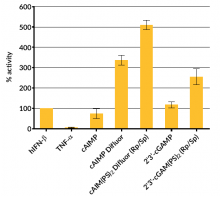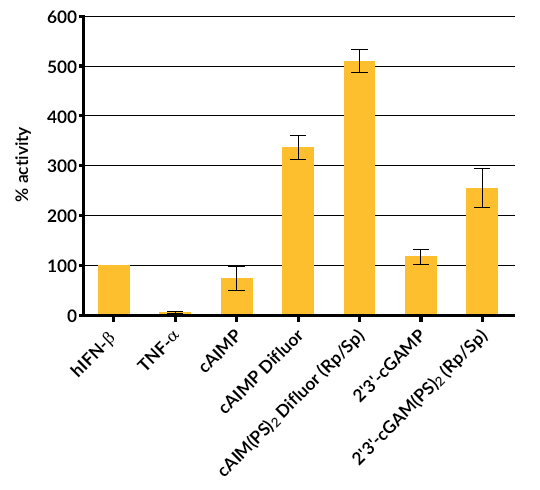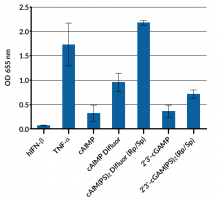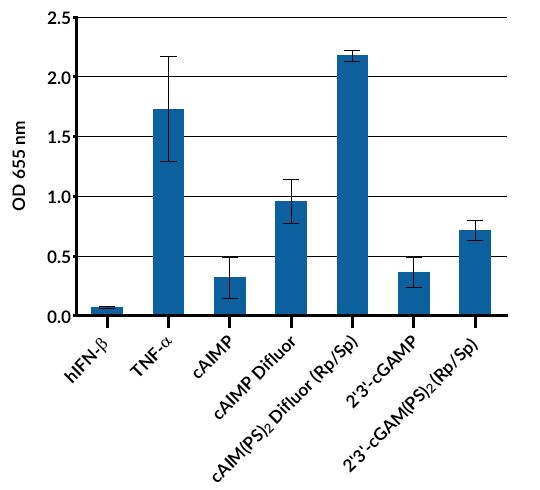cAIMP (CL592)
| Product | Unit size | Cat. code | Docs. | Qty. | Price | |
|---|---|---|---|---|---|---|
|
cAIMP Cyclic (adenine monophosphate- inosine monophosphate), a STING ligand |
Show product |
500 µg |
tlrl-nacai
|
|
Cyclic (adenine monophosphate- inosine monophosphate)
InvivoGen's cAIMP (also known as CL592) is a novel STING (stimulator of interferon genes)-activating synthetic cyclic dinucleotide (CDN) [1].
It is an analog of the bacterial CDN 3’3’-cGAMP. Unlike natural CDNs, whose constituent nucleosides are guanosine and/or adenine, cAIMP contains one adenine nucleoside and one inosine nucleoside.
STING ligands such as cAIMP induce the production of type I interferons (IFNs) and of proinflammatory cytokines through the IRF and NF-κB pathways, respectively.
Interestingly, when compared to the reference agonists for human (2’3’‑cGAMP) and murine (DMXAA) STING, cAIMP (referred to as compound 9 by Lioux et al. [1]) exhibits potency similar to 2’3’-cGAMP and is more potent than DMXAA in inducing interferon regulatory factor (IRF) and NF-κB pathways in a STING‑dependent manner [1].
To facilitate the srudy of STING ligands, InvivoGen has developed stable reporter cells in two well established immune cell models: THP-1 human monocytes and RAW 264.7 murine macrophages. These cells express inducible SEAP and/or Lucia luciferase reporter genes under the control of an IRF-inducible and NF-κB promoter.
Reference:
1. Lioux T. et al., 2016. Design, synthesis, and biological evaluation of novel cyclic adenosine-inosine monophosphate (cAIMP) analogs that activate stimulator of interferon genes (STING). J Med Chem. 59(22):10253-10267.
Back to the topSpecifications
Source: Synthetic
Synonym: 3’3’-cAIMP sodium salt, 3’3’-c(ApIp) sodium salt
CAS: 1507367-51-2
Formula: C20H23N9O13P2 .2Na
Molecular weight: 659.4 (free acid), 703.4 (sodium salt)
Solubility: 50 mg/ml in water
Quality control:
- Purity and structure has been determined by LC/MS and NMR: ≥ 95%
- The biological activity of cAIMP has been confirmed using cellular assays.
- The absence of bacterial contamination (e.g. lipoproteins & endotoxins) has been confirmed using HEK-Blue™ TLR4 and HEK-Blue™ TLR2 cells.
Contents
-
500 μg of cAIMP provided lyophilized.
Note: cAIMP is sterile filtered prior to lyophilization. - 1.5 ml endotoxin-free water









